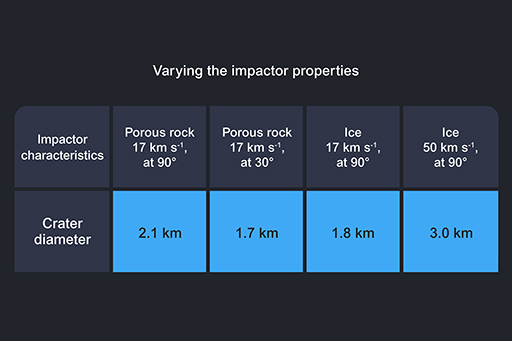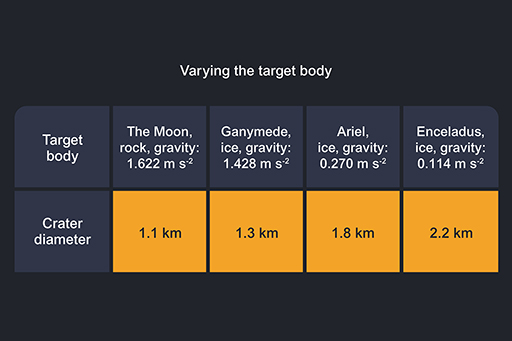4 Crater sizes
Use the three short crater calculation tables on this page to find out about the effects of a range of variables on the diameter of impact craters.
Use the data supplied to help you think about what you might expect in each case (how big will each crater be?), then select ‘Click to reveal answer’ below each diagram to see a fully labelled version and find out how good your intuition was. Don’t worry if you were way out. We do not expect you to perform calculations or work out the answers in some other way. This is a learning exercise.
Activity 4 How big will each crater be?
Porous rocky impactor (likely to be an asteroid) onto the Moon
First, find out the size of craters on the Moon formed by four porous rocky impactors that vary in diameter but are identical in composition, impact speed and impact angle.
Crater diameter is calculated according to impactor diameter, as you see in the table, and the following values:
- impact speed – 17 km s-1
- impact angle – 90° (vertical)
- surface gravity – 1.622 m s-2
- target density – 1500 kg m-3.
When you’re ready, select ‘Reveal answer’ to see the completed table.
Answer
What your results show
The 0.4-m diameter impactor represents something like the object that struck the Moon on 17 March 2013 as you saw in the ‘One “big” impact’ video. If it excavated a crater about 20 m in size, as your results suggest, then this would be easily visible by probes in lunar orbit.
Varying the impactor properties
Next you can consider different impacts onto the Moon. To make the comparison straightforward, we have fixed the impactor diameter at 40 m. You will compare impacts at identical speed but at different angles. You will also see what happens if the impactor is made of ice rather than rock. When a lump of ice hits the Moon, it is usually a comet. Since comets tend to travel faster than other impactors, you will also see the effect of greater impact speed. It should be fairly obvious that a lump of ice will make a smaller crater than a lump of rock of the same size and arriving at the same speed. But what if the ice arrives with a speed three times that of the rock?
The following values are also used to calculate the crater diameter:
- impactor diameter – 40 m
- surface gravity – 1.622 m s-2.
When you’re ready, select ‘Reveal answer’ to see the completed table.
Answer
What your results show
A 40-m diameter comet (mostly ice) hitting the Moon at the same speed as an asteroid (mostly porous rock) of the same size would make a smaller crater. However, comets tend to make bigger craters because their higher speed compensates for their lower mass. Your results also show that an oblique impact by an asteroid (30° in your example) will make a slightly smaller crater than a vertical impact of the same size and speed.
Varying the target bodies
Now investigate how the target’s composition and surface gravity affect the crater size. Slower impact speeds will be used here because, as a result of slower orbital speeds further from the Sun, lumps of ice hitting icy moons probably arrive with slower speeds than is usually the case for objects hitting the Moon.
The following impactor values are also used to calculate the crater diameter:
- impactor diameter – 40 m
- impactor composition – ice
- impact speed – 5 km s-1
- impact angle – 90° (vertical).
When you’re ready, select ‘Reveal answer’ to see the completed table.
Answer
What your results show
For fixed impact conditions, craters on the smaller (lower surface gravity) icy moons will be larger than those on the bigger icy moons, but the difference in crater size between the biggest icy moon (Ganymede) and a fairly small one (Enceladus) is less than a factor of two.
If you want to investigate further the effects of target and impactor properties on crater size, you can explore the LPL crater calculator [Tip: hold Ctrl and click a link to open it in a new tab. (Hide tip)] . This will let you calculate crater size based on the impactor (like you did here) or calculate the impactor size based on the crater. You should always use final crater size, not transient crater size. (If you try to use this calculator to replicate the results in our tables above, and this is NOT something that we are asking you to do, you will find that we have adjusted the ‘target type’ to be loose and/or porous for small craters - likely to be confined to the surface regolith layer – or competent and/or solid for larger craters – likely to extend down into stronger material.) You can also play The Open University’s ‘Meteoric’ game to see for yourself the craters that form in certain conditions.






